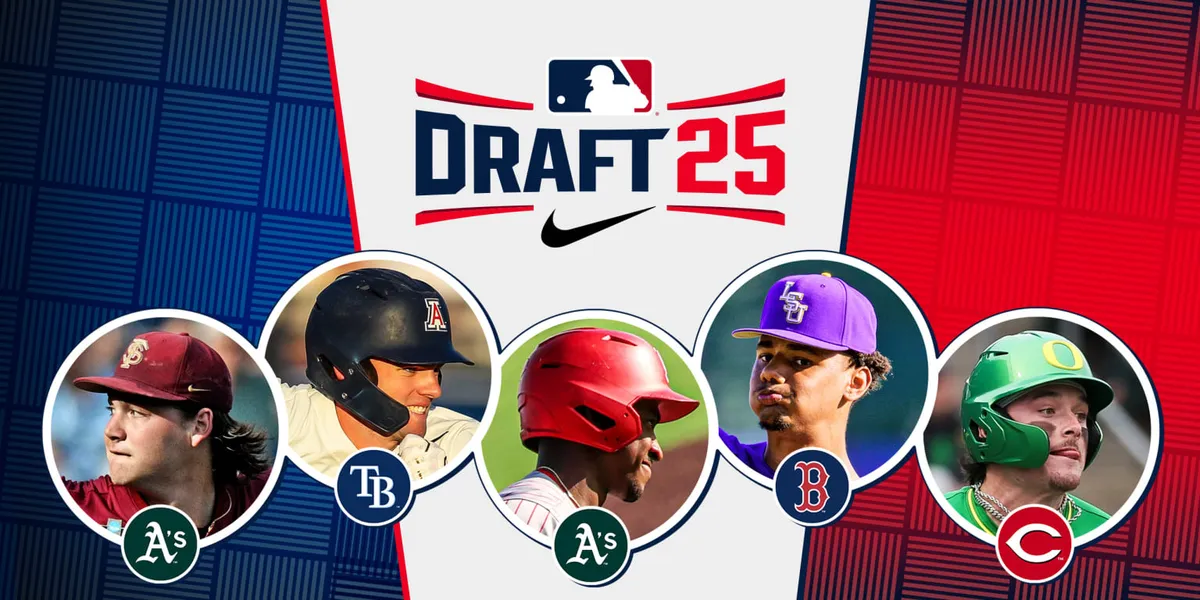
The 2025 MLB Draft has officially concluded, marking a significant shift from pre-draft predictions to in-depth analysis. The event, which encompassed 20 rounds plus compensatory selections and a total of 615 picks, offers a prime opportunity for baseball enthusiasts to dissect their favorite team's selections and uncover some of the best values from the draft. Recently, on the latest episode of the Pipeline Podcast, analysts Jim Callis, Jonathan Mayo, Sam Dykstra, and Jason Ratliff provided their insights, highlighting the biggest steals from the first ten rounds.
In the first round, the Athletics snagged Jamie Arnold, a left-handed pitcher ranked No. 11 overall, who many analysts, including Dykstra, believe has a chance to become a top-eight pick. Dykstra noted, “A lot of people have made the Chris Sale comparison due to his advanced fastball and curveball, making him a challenging at-bat.” The A's secured excellent value with Arnold, especially considering his potential exceeds that of Gage Jump, who has already made waves in the Oakland system.
In the compensation round, the Rays selected Brendan Summerhill, an outfielder ranked No. 42, who was previously projected to go as high as 16th. Callis remarked, “Despite some speculation about him sliding, I was surprised he fell to pick 42. This draft class lacked standout college hitters, and Summerhill was among the best position players available.”
The Athletics continued their successful draft strategy by picking Devin Taylor in the second round. Ranked No. 48 overall but considered the No. 30 prospect by MLB Pipeline, Mayo described Taylor as “one of the best pure college hitters in the class.” Although there are defensive questions that may push him to left field, his hitting ability and power make him a valuable asset that the A's secured at pick 48.
With their third-round pick, the Red Sox selected Anthony Eyanson, a right-handed pitcher who came in at No. 87 in the draft rankings. Dykstra noted, “The Red Sox have focused on college players, and Eyanson boasts a really good slider that could thrive in their system.” With the Red Sox's history of developing pitchers, his slider will likely be a key component of his success at Fenway Park.
The Reds landed a notable prospect in Mason Neville, an outfielder who tied for the NCAA Division I lead with 26 home runs. Ranked No. 114, Callis highlighted, “Neville had a stellar year at Oregon and was expected to go much earlier. Getting him in the fourth round is tremendous value for the Reds.” His athleticism and power make him a standout choice.
In the fifth round, the Twins picked Matt Barr, a right-handed pitcher ranked No. 149 and recognized as the best junior college player in the draft. Mayo emphasized Barr's pitching capabilities, stating, “He can spin a breaking ball exceptionally well and can reach fastball speeds up to 97 mph.”
With the sixth-round selection, the Cubs chose Josiah Hartshorn, an outfielder ranked No. 181. Dykstra shared Hartshorn's unique background, having switched hitting sides due to injuries. This young player has demonstrated power potential, making him a compelling prospect if he can maintain his health.
The Phillies selected Matthew Fisher in the seventh round, a right-handed pitcher with a ranking of No. 221. Callis remarked on Fisher's athleticism and potential, noting, “His fastball can reach 95 mph, and he possesses high spin rates on two different breaking balls.” His delivery and aptitude for a changeup suggest a bright future ahead.
In round eight, the Tigers drafted Nick Dumesnil, an outfielder ranked No. 249. Mayo recalled Dumesnil's strong sophomore year and first-round projection from previous drafts, stating, “His inconsistency this year raised concerns, but securing him in Round 8 could be an excellent decision for the Tigers given his first-round talent.”
The Pirates made a notable selection by picking Jared Jones, a first baseman ranked No. 263. Jones has established himself as one of the top power hitters in both the prep and college classes, hitting 64 home runs and winning two Men's College World Series titles at Louisiana State. His talent was projected to land him in the third or fourth rounds, making this pick a considerable win for the Pirates.
Finally, the Red Sox rounded out their top ten rounds with the selection of Maximus Martin, a shortstop/outfielder ranked No. 298. Callis described Martin as a player with impressive raw power and speed, but noted, “He needs to improve his contact skills.” The Red Sox have a strong track record of developing hitters, which could aid in Martin's growth as a player.
As teams continue to analyze their draft selections, the 2025 MLB Draft offers a plethora of talent and potential that could shape the future of Major League Baseball. Fans and analysts alike will be keeping a close eye on these prospects as they develop in the coming years.